

Nestled along the Yamuna River at the Delhi-Noida border in Uttar Pradesh, India, the Okhla Bird Sanctuary (OBS) is a celebrated destination for ornithologists and nature enthusiasts. Spanning over roughly 4 square kilometers, the sanctuary was established with the primary aim to provide a protected habitat for bird species, particularly waterbirds.
The history of the Okhla Bird Sanctuary begins with its notification in 1990 under the Wildlife Protection Act of 1972. The sanctuary was created as a response to the rapidly dwindling habitats for birds due to expansive urbanization and industrialization in the National Capital Region of India. OBS serves as a critical stopover point for migratory birds on the East Asian Flyway and supports a large variety of flora and fauna.
Tourism began to flourish at OBS as bird lovers and nature enthusiasts from India and beyond started flocking to the sanctuary to get a glimpse of the avian residents. OBS is known to house over 300 bird species, including the Critically Endangered White-rumped Vulture and the Vulnerable Sarus Crane. The sanctuary's peak visiting season coincides with the migratory period of birds between October and March when the weather is most accommodating for both the birds and the visitors.
Recent efforts to bolster tourism at OBS have included development of better infrastructure such as walking trails, watchtowers, and informative signboards to educate visitors. Accessibility to the sanctuary has been greatly enhanced through improved transportation links, including the proximity to the Delhi Metro.
One of the latest trends in tourism at OBS is the growing popularity of bird photography workshops. These workshops attract amateurs and professional photographers who wish to capture the stunning biodiversity of the area. Eco-tourism has also gained momentum, with greater emphasis on conservation education and sustainable visitation practices to minimize the impact on the natural environment.
Despite its popularity, OBS faces challenges such as pollution and encroachment threats. However, through joint efforts by government bodies, NGOs, and wildlife enthusiasts, conservation programs are actively being implemented to preserve this precious ecosystem. Efforts include habitat restoration projects, pollution control measures, and legal actions against habitat encroachment.
For those planning a visit to the Okhla Bird Sanctuary, entry is regulated to ensure minimal disturbance to the wildlife. Visitors are encouraged to follow the guidelines set by the sanctuary management, which include adhering to designated paths, maintaining a respectful distance from the wildlife, and avoiding the use of loud noises that may disturb the birds.
The Okhla Bird Sanctuary remains a significant and cherished biodiversity hotspot in the heart of a bustling urban landscape. It continues to attract tourists from around the globe, providing them with a serene and educative experience amidst the wonders of the avian world. As it navigates the challenges of modernity, the sanctuary stands as a testament to the importance of balancing ecological preservation with sustainable tourism.